JGraph document Model
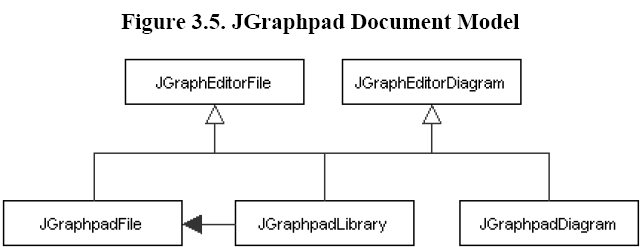
library
是预定义的
cell
。
示例:
int number = model.getChildCount(file) + 1;
JGraphpadDiagram newDiagram = new JGraphpadDiagram(
getString("Diagram") + number);
model.addChild(newDiagram, (JGraphpadFile) file);
model.removeNodeFromParent(mutableTreeNode);

All JGraphpadFile and JGraphpadLibrary objects are roots, and
all JGraphpadDiagram objects are direct children of JGraphpadFile objects.
The root contains one or more files (documents or libraries), and the documents contain one or more diagrams.
factory methods定制之Main Window
[1]
主窗口结构如下:
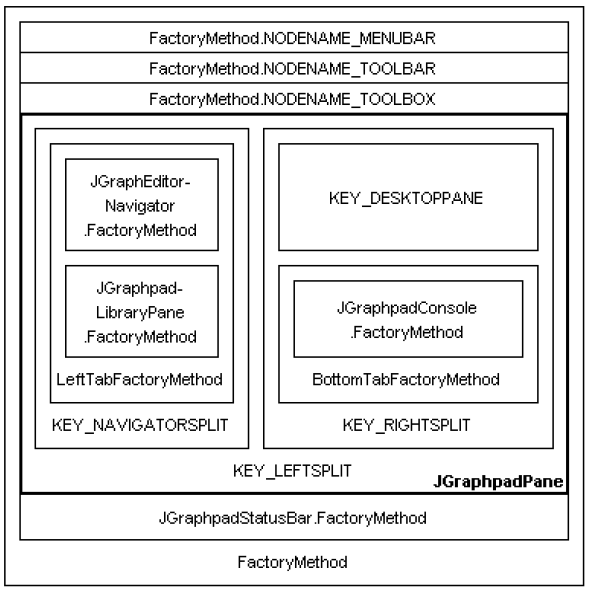
JGraphpadPane
.FactoryMethod
创建主窗口,
负责整个
JFrame
实例的创建(包括
menubar, toolbar, toolbox, statusbar and main area
)
main area
包括:
left
,
content
,
bottom
三部分。
Left
和
bottom
由各自的
factory methods
创建,返回
JTabbedPane.
示例:创建
toolbox
,以
Node
为参数创建
:
Node toolboxConfig = JGraphEditorSettings.getNodeByName(
configuration
.getChildNodes(), NODENAME_TOOLBOX);
JGraphEditorToolbox toolbox = editor.getFactory()
.createToolbox(toolboxConfig);
configuration
对象代表
xml
格式的
ui
描述中的最外层结点(例如下面的
xml
),
getNodeByName
获取名为
toolbox
的结点。
<ui>
<toolbox>
<item key="selectTool"/>
<separator/>
<item key="createDashPatternCombo"/>
</toolbox>
</ui>
menubar
和
toolbar
也是类似:
Node menuBarConfig = JGraphEditorSettings.getNodeByName(
configuration.getChildNodes(), NODENAME_MENUBAR);
frame.setJMenuBar((JMenuBar) editor.getFactory().createMenuBar(
menuBarConfig));
[...]
Node toolbarConfiguration = JGraphEditorSettings.getNodeByName(
configuration.getChildNodes(), NODENAME_TOOLBAR);
JToolBar toolbar = editor.getFactory().createToolBar(
toolbarConfiguration);
注意下面,没有以
Node
做参数
而是直接创建:
Component statusBar = editor.getFactory().executeMethod(
JGraphpadStatusBar.FactoryMethod.NAME);
frame.getContentPane().add(statusBar, BorderLayout.SOUTH);
[2]
主窗口的组件
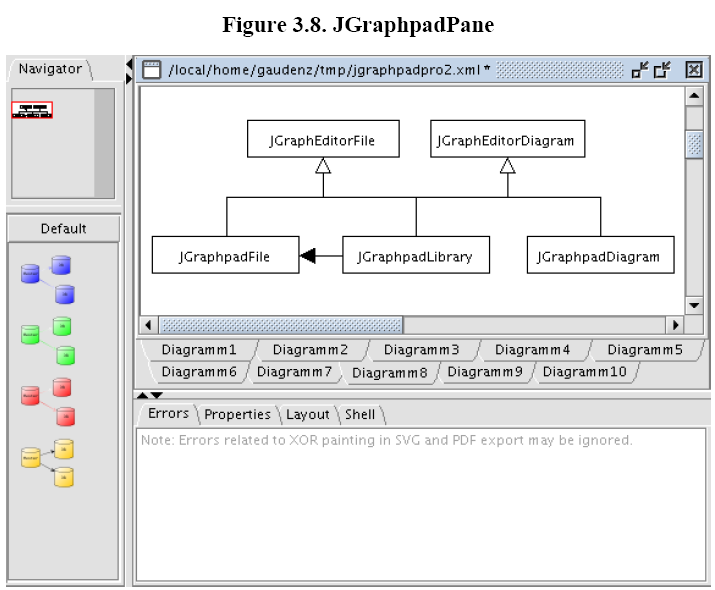
窗口的
main area
是
JGraphPane
,分为
3
部分,
left
和
bottom
是由
factory method
创建,而
content
(
JDeskTopPane
)部分在
constructor
中创建。
Component leftTab = editor.getFactory().executeMethod(
LeftTabFactoryMethod.NAME);
Component bottomTab = editor.getFactory().executeMethod(
BottomTabFactoryMethod.NAME);
三部分的位置信息注册到
settings
对象
,供显示和退出保存。
Content
被注册了一个鼠标监听器:
desktopPane.addMouseListener(new JGraphpadMouseAdapter(editor,
NODENAME_DESKTOPPOPUPMENU));
这个监听器根据配置文件处理右键弹出窗口问题。
JGraphpadPane
另外有些
method
,其用途是
供
DocumentTracker
调用,以同步
model
的各种变化。
在其中有个
configureDiagramPane hook which is called when a new diagram pane is created for a diagram
[3]
left tab
left
是一个
JSplitPane
:
factory.executeMethod(JGraphEditorNavigator.FactoryMethod.NAME);
factory.executeMethod(JGraphpadLibraryPane.FactoryMethod.NAME);
JSplitPane navigatorSplit = editor.getFactory().createSplitPane(
navigator, libraryPane, JSplitPane.VERTICAL_SPLIT);
editor.getSettings().putObject(
KEY
_NAVIGATORSPLIT, navigatorSplit);
为了记住
JSplitPane
的当前位置信息,添加
shut down hook
editor.getSettings().addShutdownHook(
new JGraphEditorSettings.ShutdownHook() {
public void shutdown() {
editor.getSettings().storeSplitPane(
JGraphpad.NAME_USERSETTINGS,
KEY
_NAVIGATORSPLIT);
}
});
[4]
bottom tab
bottom
是一个
JTabbedPane
,如下:
JTabbedPane tabPane = editor.getFactory().createTabbedPane(
JTabbedPane.TOP);
Component console = editor.getFactory().executeMethod(
JGraphpadConsole.FactoryMethod.NAME);
if (console != null)
tabPane.addTab(JGraphEditorResources.getString("Errors"),
editor.getFactory().createScrollPane(console));
factory methods定制之Library Pane
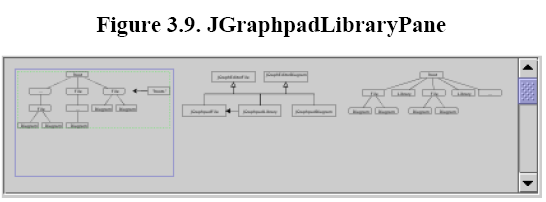
The library pane is inserted into the main area of the JGraphpadPane and displays the entries in the library.
The library supports drag and drop and copy, paste, cut and delete, and has a reference to the library
in the document model.
待续。。。
factory methods定制之Window Menu

创建并注册到
settings
JMenu menu = new JGraphpadWindowMenu();
editor.getSettings().putObject(
KEY
_WINDOWMENU, menu);
JGraphpadWindowMenu
由静态和动态
entities
两部分,后者是保存在
List
。
当内部的
frame
(多窗口程序)变化时(
remove
或
add
),后者会相应变化。
factory methods定制之Open Recent Menu
由
JGraphpadOpenRecentMenu
实现,也是动态的,
通过读取保存在一个
property
对象中的
List
tmp = props.getProperty(
KEY
_RECENTFILES + i++);
更新“最近的文档”的记录:
editor.getSettings().pushListEntryProperty(
NAME_USERSETTINGS,
KEY
_RECENTFILES, filename,
MAX
_RECENTFILES);
factory methods定制之Status bar
JGraphpadStatusBar
是
JPanel
的扩展,
在
constructor
中用工厂方法创建,并且注册所有关心的
listeners
,即
焦点的传递,和模型的事件,当前
graph
的鼠标移动事件,
factory methods定制之console
com.jgraph.pad.factory.JGraphpadConsole
继承
JTextArea
,
连接到
out
或
err
系统流。
factory methods定制之combo boxes

除去framework提供的combo box外,pad提供了关于颜色和shape的combo box。
factory methods定制之custom tools
framework
只对
tools
支持名字和
isAlwaysActive
属性。而继承的
JGraphpadVertexTool
和
JGraphpadEdgeTool
支持更多,并且后者用从前缀继承。
两者都使用了
prototype
。
The vertex tool is used to insert cells with bounds,
the edge tool is used to insert cells with points
添加tool,使用
createVertexTool
createEdgeTool
下面以一个
tree
作为
user object为例:
JTree tree = new JTree();
tree.setRootVisible(false);
kit.addTool(createVertexTool("treeTool", tree,
JGraphpadVertexRenderer.SHAPE_RECTANGLE, null));
边框会在插入时刻被添加。
kit.addTool(createEdgeTool("orthogonalEdgeTool",
"", GraphConstants.ROUTING_SIMPLE));
最后,添加到配置文件
# treeTool
treeTool.tooltip=Tree
treeTool.icon=/com/jgraph/pad/images/tree.gif
和ui的xml
<toolbox>
[...]
<item key="treeTool"/>
</toolbox>
factory methods定制之Dialogs
内置对话框:
文件对话框:
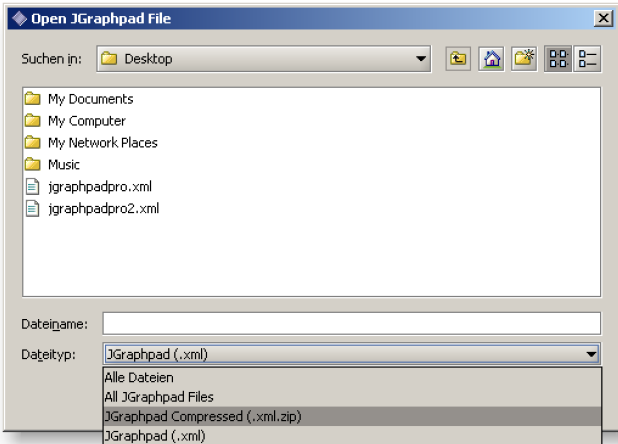
使用如下:
JGraphpadDialogs.getSharedInstance().editorFileDialog(
getActiveFrame(), getString("OpenJGraphpadFile"),
null, true, ".csv",lastDirectory)
文件对话框会以上次目录为当前目录。
上面的参数true指明对话框类型:open
字体对话框:
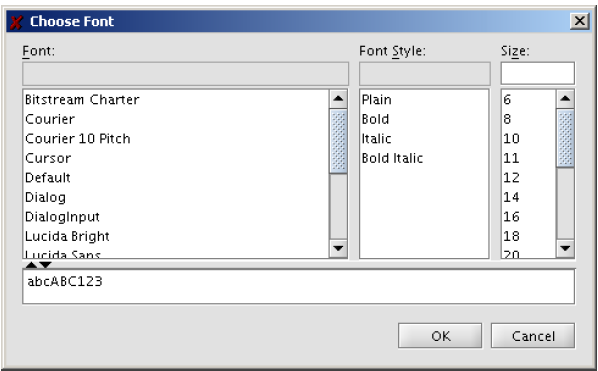
about对话框:
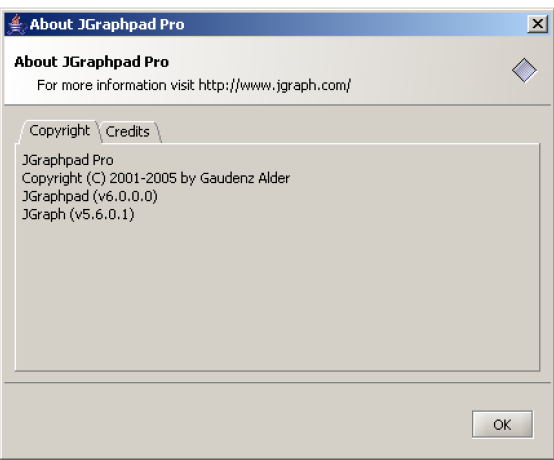
授权对话框
:
JGraphpadAuthenticator
继承
java.net. Authenticator
用来获取基于网络的授权
。
不直接使用,而是作为默认的对话框,以参数形式传递给
Authenticator
Authenticator.setDefault(new JGraphpadAuthenticator());
工具类
























 1万+
1万+

 被折叠的 条评论
为什么被折叠?
被折叠的 条评论
为什么被折叠?








